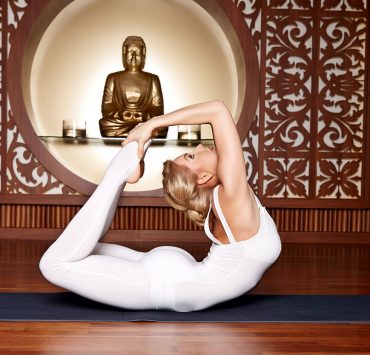
Meditation coach Emma Morrison is the go-to person for those…
The practice of yoga teaches us many things. Most importantly, we are taught to take what we learn on the mat and apply it to our lives off the mat.
The Yoga Sutras by Patanjali guides the philosophy of yoga beyond the asana practice. The Yamas and Niyamas act as moral and ethical guides that lead you along the path of the Eight Limbs of Yoga. These specific teachings help us to develop a greater awareness of ourselves and others.
Today, we are going to be focusing on the last Yama in the Yoga Sutras: Aparigraha.
What is Aparigraha?
Aparigraha is Sanskrit for non-attachment. It can also be translated as non-possessiveness or non-greed. This important Yama teaches us to take only what we need and keep only what serves us in the present moment.
It urges us to let go of things when the time is right.
Some people exercise Aparigraha as refraining from accumulating unnecessary possessions. Others refuse to accept bribes or gifts that would compromise their values.
But deeper approaches ask us to consider why we feel the need to acquire such things in the first place.
Aparigraha can be practiced through selfless service, hatha yoga, or meditation. These activities will help quiet the desiring mind. Over time, you will develop a greater sense of contentment and inner peace. Even a small hint of this inner fulfillment can provide us a foundation of moderation. As we seek what we desire, we must address what we truly need.
With practice, refraining from greed can evolve into positive actions of generosity.
Generosity arises naturally from a sense of deep connection and can take many forms. Generosity might be giving someone a warm smile, taking the time to appreciate someone you love, or a silent prayer you offer to uplift a friend in need.
Sharing gifts and blessings is a natural impulse when we acknowledge our abundance. We must escape the self-centered messages in our culture and reframe our thinking.
With practice, you may find it even more fulfilling to give than to keep things for yourself.
Aparigraha teaches us to never concern ourselves with the outcome of a situation. Instead, we should only concern ourselves with what we are doing right now. While certainly a process, Aparigraha can provide us a deeper sense of peace through moderation and restraint.
Below are some ways to practice Aparigraha in your everyday life.
#1 Sort Out Unneeded Clothing

We have all had the experience of buying clothes and never wearing them. We even live in a culture that shames wearing the same outfit twice. But why are we taught to accumulate more than we need?
Try sorting out clothes from your wardrobe that don’t bring you joy.
If you find yourself wearing the same clothes over again, this could be a good indication of what clothes make you happy. But if you like having a variety in your wardrobe, try getting pieces that can be mixed and matched to make more outfit options without too much clutter.
Sorting out your clothes in this way will help you focus on what’s important.
Derive joy from the feeling your clothes give you, not from the number of clothes that you own.
#2 Offer Unneeded Furniture To Those In Need

Furniture is another thing we accumulate unnecessarily. Sometimes, it’s easy to lose track of the actual space we inhabit. Clearing your living space of unused furniture can help calm the mild. This will also help you focus on what you need and use.
There are so many others who may not have enough furniture or any at all. Consider donating your unused furniture to places like Goodwill for families and individuals in need.
Remember that furniture is made for a purpose.
If you’re not using it, let it go elsewhere where it can serve the way it was meant to serve.
#3 Scour Through Miscellaneous Possessions and Donate Them

The keyword here is miscellaneous. This is not to say get rid of personal belongings altogether. Sometimes, there are physical items that are very meaningful. They may have been passed down from generation to generation. They might remind you of someone that you love. These are valuable objects to hold on to.
It’s the miscellaneous that serves no purpose.
If it has no meaning and does not give you any joy, it is something that you can let go of.
Besides, what may be miscellaneous to you could be very meaningful to someone else. Another person’s trash is another person’s treasure. Allow these items to serve their purpose elsewhere.
#4 Regift Items as an Act of Kindness or Expression of Love

Gifting items can allow you to create a connection with others. After all, the point of gifting is giving, not buying a new model of the latest style.
Regifting allows for a mutual relationship between release and acceptance.
It is an energy that flows between you and another individual. Gifting also allows you to act out of kindness and generosity. Through this act, you can express your love through physical means.
Let regifting be an extension of your compassion and care. Let it create joy in you as well as the person receiving the gift.
#5 Pay Attention to Your Breath

The simple act of inhaling and exhaling can teach you about Aparigraha. By letting yourself let go through an exhale, you are allowing yourself to inhale once again.
Breathing teaches us that letting go is just as important as taking in.
Receiving and giving go hand in hand. You cannot have one without the other.
Focusing on your breath also reminds us to recognize the simplicity of this act. Our body naturally breathes in and out constantly. It knows when to release what no longer serves. It also knows when it needs to take in nourishment.
Let your breath guide you in your practice of non-attachment.
#6 Journal Your Observations and Experiences.

Journaling can help focus the mind while also letting it wander. Actualizing your thoughts on paper will allow you to see them more clearly.
The act of journaling also allows you the opportunity to explore your subconscious. You may discover what you’re not able to let go of. Sometimes these attachments can go unnoticed.
You can also explore new ideas and make room for new beginnings.
Journaling can make us present and allow us to reflect on what we need versus what we want.
#7 Allow Yourself to Focus on Mundane Activities

This is a great way to apply yogic philosophy to seemingly mundane tasks. You can practice being present when washing the dishes, hammering a nail, or moving furniture. Your attention to the present moment will connect you to your breath.
Soon, you will realize that these tasks are no different from the postures on your yoga mat.
When we focus on the outcome of the work, we distract ourselves from what we are doing. Instead, focus on the integrity of your thoughts, intentions, and actions. This way, you are not attached to the future or your expectations of it.
Be an active observer and participant in the present moment regardless of the task at hand.
#8 Practice Yoga for the Love of Practicing

At the beginning of our yoga practice, we are often set on our intention and actively engaged. But about halfway through, we may lose sight of that intention. Other thoughts might start to distract us and the purpose of the present moment becomes muddied.
Home practice is a great way to experience the benefits of getting on your mat more often. This way, you can choose when you need to settle your mind and move beyond the physical practice.
Sometimes, we may worry too much about the poses themselves.
Try to be satisfied with the moment without greed or want.
Practice and progress are encouraging and creative. The joy is practice is the reward itself and frees us from having a specific goal in mind. Move your body in a way that feels good and you will have achieved that reward.
Remember to practice for the love of practicing. Don’t force or push yourself over the edge. Your body will naturally respond to your compassion.
#9 Consider What Will Bring You Happiness

We live in a society that idolizes material possessions. The more things we have though, the more we weigh ourselves down with physical and energetic baggage. Soon, we become more too attached to these possessions. We fear losing them and place far too much emphasis on the object themselves.
Instead, recognize when you feel the desire to attain more materials possessions.
Ask yourself what enters your mind in these moments. What makes you feel like you are lacking? Refocus your mind away from “lack” and move towards living a life less cluttered. The next time you buy something new, take a moment to consider why you need it.
Will this object bring lasting happiness? Will it help you find inner peace? Will it help you live a more self-reliant and simpler life?
#10 Eat Moderately

Many yogic texts advise eating moderately as a way to align with your practice. You can still enjoy your favorite meals and treats, but just make sure to nourish yourself and stay healthy.
Aparigraha can help us listen to our bodies and recognize when enough is enough.
You may have heard about the world’s “blue zones.” These are areas with the highest life expectancy and healthiest quality of life. In these blue zones, individuals tend to eat until they are 80% full. This way, their food can digest properly. Try following the rule of thumb that originated in Okinawa.
“Hara Hachi Bu.” This means “Eat until you are eight parts full.”
As you consider how much you eat, also consider how much you throw away. 30%-50% of the food produced in the world ends up in waste. Demands for food are ever-growing but well over 8 million people go hungry every day. This comes from the overbuying and wasting of food.
Next time you go to the grocery store, try sticking to your shopping list. Don’t indulge in extra treats. Cook big meals to share with friends and make sure that nothing goes to waste. Extra food today can be saved for tomorrow’s lunch or dinner.
Also, consider donating tins of food to those in need. Try volunteering at a local food pantry and give back to your community in a meaningful way.
#11 Experience the Good and the Bad

“Parinamavada” is Sanskrit and can be translated as “everything is in a constant state of flux.” This principle teaches us that change is the only constant thing we can expect in life. But it can be easy to become attached to only positive feelings and experiences.
Truly experiencing positivity does not mean clinging on to it.
It means letting things happen as they happen. Accept the bad parts all the same as you would the good parts.
Our physical bodies change every second. Cells regenerate, blood flows, bone wears down and stimulates back up again. Our breath moves in and out of the body without our having to think about it.
Let your mind experience this change too. Allow yourself to feel sadness, anger, and loss in tandem with happiness, joy, and peace. When we let the moment be exactly what it is, we are truly present. By allowing things to come and go, we eliminate the need to possess any of it.
#12 Focus Your Energy on the Present Moment

Being in the present moment allows us to be free. When we work and do what we love without worrying about the outcome, we allow ourselves to enjoy the process for all that it is.
Freedom relies less on external and material possession to bring us happiness. Instead, freedom offers us everything in life, whatever those things may be.
Nothing is more important than what is happening right now.
Don’t cling to it and don’t miss it when it moves on.
What's Your Reaction?
Meditation coach Emma Morrison is the go-to person for those living in Salt Lake City, Utah, who need to release stress and tension or simply dive deeper into their meditation practice. In her writing, you’ll receive useful information on how to live a more fulfilling life.














